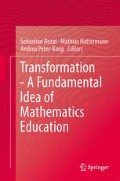Abstract
The aim of this article is to present a certain view on the reading of mathematical texts. Using an example it will be shown that readings of mathematical texts may be codetermined by different readers’ transformations. As an example of such a kind of reading, a theorem from a nineteenth-century-geometry textbook is introduced. To comprehend the meaning of this geometry and to be able to follow all the arguments offered, the text and some proofs are transformed into a more up-to-date kind of geometry. This transformation can be characterized by a transfer of the author’s use of diagrams to the reader’s use of diagrams. In addition, this transfer of use can be supplemented occasionally by the use of an alternative set of diagrams. This means that the use of diagrams that are well known to the reader of a mathematical text may considerably support his/her construction of knowledge.
Access this chapter
Tax calculation will be finalised at checkout
Purchases are for personal use only
Notes
- 1.
On the use of textbooks in mathematics, see Rezat, 2010.
- 2.
Max Simon (born in Kolberg in 1844, died in Strassburg in 1918), mathematics teacher and historian of mathematics, PhD 1867 by Weierstrass and Kummer.
- 3.
To give an example of a sign we can think of a barometer as representamen, which gives some information about its object, the air pressure. A person recognizing a change of the air pressure can interpret this change. It is remarkable that the representamen itself can be called a sign. For more information see the previously cited literature.
References
Anderson, M., Sáenz-Ludlow, A., Zellweger, S., & Cifarelli, V. V. (Eds.). (2003). Educational perspectives on mathematics as semiosis: from thinking to interpreting to knowing. New York: Legas.
Arzarello, F., Olivero, F., Domingo, D., & Robutti, O. (2002). A cognitive analyisis of dragging practices in Cabri environments. Zentralblatt für Didaktik der Mathematik, 34(3), 66–72.
Bakker, A., & Hoffmann, M. H. G. (2005). Diagrammatic reasoning as the basis for developing concepts: A semiotic analysis of students’ learning about statistical distribution. Educational Studies in Mathematics, 60(3), 333–358.
Boehm, G. (1994). Die Wiederkehr der Bilder. In G. Boehm (Ed.), Was ist ein Bild? (pp. 11–38). München: Wilhelm Fink Verlag.
Cobb, P., Yackel, E., & McLain, K. (Eds.). (2000). Symbolizing, Modeling and Instructional Design. Mahwah, NJ: Lawrence Erlbaum Associates Publishers.
Coulmas, F. (2003). Writing systems. An introduction to their linguistic analysis. Cambridge UK: Cambridge University Press.
Dörfler, W. (2006). Diagramme und Mathematikunterricht. Journal für Mathematik-Didaktik, 27(3/4), 200–219.
Freudenthal, H. (1973). Mathematik als paedagogische Aufgabe. Stuttgart: Klett.
Goldin, G. (1998a). The pme working group on representations. Journal of Mathematical Behavior, 17(2), 283–299.
Goldin, G. (1998b). Representational systems, learning and problem solving in mathematics. Journal of Mathematical Behavior, 17(2), 137–165.
Goodman, N. (1976). Languages of art. An approach to a theory of symbols. Indianapolis: Hackett Publishing Company.
Harris, R. (2001). Rethinking writing. London: Athlone Press.
Heintz, B. (2000). Die Innenwelt der Mathematik. Wien: Springer.
Hoffmann, M. (Ed.). (2003). Mathematik verstehen. Semiotische Perspektiven. Hildesheim. Berlin: Franzbecker.
Hoffmann, M. H. G. (2005). Erkenntnisentwicklung. Frankfurt am Main: Vittorio Klostermann.
Hoffmann, M. H. G. (2006). What is a "semiotic perspective", and what could it be? Some comments on the contributions to this special issue. Educational Studies in Mathematics, 61, 279–291.
Kadunz, G. (2006). Schrift und Diagramm: Mittel beim Lernen von Mathematik. Journal für Didaktik der Mathematik, 27(3/4), 220–239.
Krämer, S. (2003). >Schriftbildlichkeit< oder: Über eine (fast) vergessene Dimension der Schrift. Bild, Schrift, Zahl. S. Krämer and H. Bredekamp (157–176). München: Wilhelm Fink.
Latour, B. (1987). Science in Action: How to Follow Scientists and Engineers through Society. Cambridge, MA: Harvard University Press.
Mitchell, W. J. T. (1994). Picture theory. Chicago: The University of Chicago Press.
Nöth, W. (2000). Handbuch der Semiotik (2 ed.). Stuttgart, Weimar: J.B. Metzler.
Oliveri, G. (1997). Mathematics, a science of patterns? Synthese, 112, 379–402.
Peirce, C. S. (1998). The essential peirce = EP. Bloomington and Indianapolis: Indiana University Press.
Presmeg, N. (2006). Semiotics and the “connections” standard: significance of semiotics for teacher of mathematics. Educational Studies in Mathematics, 61, 163–182.
Sáenz-Ludlow, A., & Presmeg, N. (2006). Guest editorial semiotic perspectives on learning mathematics and communicating mathematically. Educational Studies in Mathematics, 61, 1–10.
Schreiber, C. (2010). Semiotische Prozess-Karten—chatbasierte Inskriptionen in mathematischen Problemlöseprozesse. Münster: Waxmann.
Seeger, F. (2000). Lernen mit grafischen Repräsentationen: Psychologische und semiotische Überlegungen. Semiotik, 22(1), 51–79.
Simon, M. (1915). Analytische Geometrie der Ebene (3 ed.). Berlin, Leipzig: Goeschen.
Stjernfelt, F. (2000). Diagrams as centerpiece of a peircian epistemoloy. Transactions of Charles S. Peirce Society, XXXVI(3), 357–384.
Author information
Authors and Affiliations
Corresponding author
Editor information
Editors and Affiliations
Rights and permissions
Copyright information
© 2014 Springer Science+Business Media, LLC
About this chapter
Cite this chapter
Kadunz, G. (2014). Constructing Knowledge by Transformation, Diagrammatic Reasoning in Practice. In: Rezat, S., Hattermann, M., Peter-Koop, A. (eds) Transformation - A Fundamental Idea of Mathematics Education. Springer, New York, NY. https://doi.org/10.1007/978-1-4614-3489-4_7
Download citation
DOI: https://doi.org/10.1007/978-1-4614-3489-4_7
Published:
Publisher Name: Springer, New York, NY
Print ISBN: 978-1-4614-3488-7
Online ISBN: 978-1-4614-3489-4
eBook Packages: Humanities, Social Sciences and LawEducation (R0)

